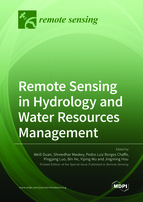Remote Sensing in Hydrology and Water Resources Management
A special issue of Remote Sensing (ISSN 2072-4292). This special issue belongs to the section "Environmental Remote Sensing".
Deadline for manuscript submissions: closed (31 January 2021) | Viewed by 89917
Special Issue Editors
Interests: remote sensing for hydrological applications; hydrological big data; sustainable water resource management; extreme climate events
Special Issues, Collections and Topics in MDPI journals
Interests: mountain hydrology; process-based distributed hydrological modeling; flood and drought forecasting; snow/glaciers modeling; uncertainty analysis and climate change impacts and adaptation
Interests: watered hydrology; process-based distributed hydrological modeling; climate change
Special Issues, Collections and Topics in MDPI journals
2. School of Water and Environment, Chang’an University, 710064 Xi’an, China
Interests: urban flood; flood management; hydrological modeling; water quality analysis; statistical analysis; sustainable water resource management; ecohydrology
Special Issues, Collections and Topics in MDPI journals
Interests: soil environment; soil pollution; nonpoint source pollution; water-related disasters; hydrological modeling; geographical information system
Special Issues, Collections and Topics in MDPI journals
Interests: eco-hydrological processes; water–carbon cycles; numerical modeling
Interests: hydrodynamic modeling; flood management; low-impact development measures; eco-hydraulics; environmental hydraulics; sediment transport
Special Issues, Collections and Topics in MDPI journals
Special Issue Information
Dear Colleagues,
In the last few decades, remote sensing (RS) technology has developed rapidly, which provides a means of observing hydrological and hydraulic state variables including precipitation, temperature, soil moisture, water levels, evapotranspiration, flood extent, flow velocity, river discharge, and land water storage over regional/global areas. All these variables could be the input files for integrated hydrodynamics or hydrological or hydrometeorological models to simulate and assess water resources and water-related issues, contributing to fully understand global- and regional-scale hydrological processes under climate change and human activities. Improved understanding of changes in global to regional and basin scale hydrological system is imperative to manage water resources sustainably. The objective of this special issue is to present reviews and recent advances of general interest that make use of remote sensing techniques in hydrology and water resources management. Manuscripts on all aspects related with remote sensing in hydrology and water resources management are welcome. Paper topics may include but are not limited to the following:
(1) Satellite remote sensing for water resources management.
(2) Ground validation of remote sensing observations of soil moisture, water depth, precipitation, temperature, river discharge, and so on.
(3) Remote sensing of snow and glacier cover.
(4) Water quality monitoring and evaluation using remote-sensing data.
(5) Remote sensing and flood inundation modelling.
(6) Remote sensing for detecting the global impact of climate extremes.
(7) Use of remote sensing data for improved calibration of hydrological models.
Dr. Weili DuanDr. Shreedhar Maskey
Dr. Pedro Luiz Borges Chaffe
Dr. Pingping Luo
Dr. Bin He
Dr. Yiping Wu
Dr. Jingming Hou
Guest Editors
Manuscript Submission Information
Manuscripts should be submitted online at www.mdpi.com by registering and logging in to this website. Once you are registered, click here to go to the submission form. Manuscripts can be submitted until the deadline. All submissions that pass pre-check are peer-reviewed. Accepted papers will be published continuously in the journal (as soon as accepted) and will be listed together on the special issue website. Research articles, review articles as well as short communications are invited. For planned papers, a title and short abstract (about 100 words) can be sent to the Editorial Office for announcement on this website.
Submitted manuscripts should not have been published previously, nor be under consideration for publication elsewhere (except conference proceedings papers). All manuscripts are thoroughly refereed through a single-blind peer-review process. A guide for authors and other relevant information for submission of manuscripts is available on the Instructions for Authors page. Remote Sensing is an international peer-reviewed open access semimonthly journal published by MDPI.
Please visit the Instructions for Authors page before submitting a manuscript. The Article Processing Charge (APC) for publication in this open access journal is 2700 CHF (Swiss Francs). Submitted papers should be well formatted and use good English. Authors may use MDPI's English editing service prior to publication or during author revisions.
Keywords
- Satellite altimetry
- Remote sensing in hydrology
- Theory and techniques of hydroinformatics
- Data assimilation
- Hydrological big data
- Extreme climate events
- Sustainable water resource management
- Urban flood and waterlogging
- Ecological hydrology
- Soil and water conservation
- Environmental engineering
- Geological disasters
- Water-related disaster
- Nonpoint source pollution
- Water pollution treatment
- Eco-hydrological processes
- Water–carbon cycles
- Numerical modeling










